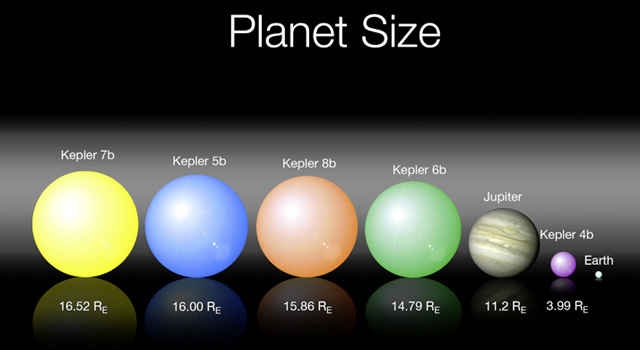Kepler Planet-Hunting Mission Finds 5 New Lightweight Worlds

This story was updated at 3:10 p.m. ET.
WASHINGTON — The list of known exoplanets in the galaxy just got bigger, thanks to the first observations of NASA's Kepler space telescope, which found five new lightweight worlds orbiting distant stars.
"I would like to announce today the discovery of five exoplanets by Kepler," said Kepler science director William Borucki of NASA's Ames Research Center in Moffett Field, Calif., here today at the 215th meeting of the American Astronomical Society.
The planet-hunting Kepler, which hopes to discover alien Earths, also found an odd object orbiting a star and is measuring the quakes that ripple across stellar surface.
The five newfound planets are all much larger than the Earth-sized bodies Kepler was designed to find, with one coming in at around the size of Neptune, and the other four measuring larger than Jupiter.
All five planets orbit very close to their stars, with orbital periods of around three to four days, and so are very hot. Their temperatures are above those of molten lava; even iron would melt on their surfaces.
"So these are very hot, very bright planets," Borucki said.
Get the Space.com Newsletter
Breaking space news, the latest updates on rocket launches, skywatching events and more!
While the Neptune-sized planets, dubbed Kepler 4b, is about the density of the ice giants in our solar system (and so likely has an abundance of elements heavier than hydrogen and helium), one of the other newfound planets, Kepler 7b, has one of the lowest densities of any planet ever discovered, Boruckisaid.
Its density is less than that of water and "is the same as Styrofoam," Borucki said, providing astronomers with a puzzle of just what the structure of these lightweight planets is.
While these planets aren't the type that scientists hope Kepler will ultimately find, the observations that the telescope has made so far show that "we do have the sensitivity to find Earth-size planets," Borucki said.
Kepler, which launched on March 6, 2009, looks for dips in the light curves of stars that indicate a planet transiting in front of the star (from the perspective of Earth).
Kepler also observes occultations of planets, or the light curve dips that occur when the planet moves behind its parent star. The telescope has made one strange observation of a system where the light curve from the orbiting body dips more during the occultation than during its transit, which suggests that it is much hotter than its parent star – certainly an odd situation for a planet-star system. The body could be a small, relatively cool white dwarf, but its size is too big for most white dwarfs.
"So we're not quite sure what we're seeing here," Borucki said.
Kepler monitored several sun-like stars to see if they were quiescent enough to both allow life to form on any orbiting planets and allow astronomers to detect these planets. The telescope's observations show that many of the stellar twins are about as active as the active sun or quieter.
"It's good news for exobiology," said Kepler team member Natalie Batalha of San Jose State University, as it means these stars don't scour the surfaces of their planets, providing a haven for life to potentially form. Fewer fluctuations in the star's brightness also makes it easier for astronomers to discern any planets – particular any that are Earth-sized and in the star's so-called habitable zone, the range of orbits where water would remain liquid on the planet's surface.
Kepler has also shown its ability to measure the oscillations that occur at a star's surface that cause it to "ring like a bell" and its brightness to vary. Studying this stellar seismology can help scientists better understand the age and structure of stars. Kepler data for one star has pinned down that star's diameter from within a 10 percent margin of error to within 1 percent.
"This in turn gives astronomers much better knowledge of the planet's density, in the case studied this has improved from about 50 percent uncertainty to five percent, which is very important for understanding exoplanets, said Ron Gilliland of the Space Science Institute in Baltimore, Md., and the principal investigator for Kepler's astroseismology program.
The results announced at the meeting come from just the first 43 days of Kepler observations; scientists now have more than eight months of data to comb through, Borucki said.
Join our Space Forums to keep talking space on the latest missions, night sky and more! And if you have a news tip, correction or comment, let us know at: community@space.com.

Andrea Thompson is an associate editor at Scientific American, where she covers sustainability, energy and the environment. Prior to that, she was a senior writer covering climate science at Climate Central and a reporter and editor at Live Science, where she primarily covered Earth science and the environment. She holds a graduate degree in science health and environmental reporting from New York University, as well as a bachelor of science and and masters of science in atmospheric chemistry from the Georgia Institute of Technology.









